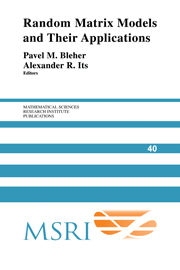Book contents
- Frontmatter
- Contents
- Preface
- Symmetrized Random Permutations
- Hankel Determinants as Fredholm Determinants
- Universality and Scaling of Zeros on Symplectic Manifolds
- z-Measures on Partitions, Robinson-Schensted-Knuth Correspondence, and β = 2 Random Matrix Ensembles
- Phase Transitions and Random Matrices
- Matrix Model Combinatorics: Applications to Folding and Coloring
- Interrelationships Between Orthogonal, Unitary and Symplectic Matrix Ensembles
- Dual Isomonodromic Tau Functions and Determinants of Integrable Fredholm Operators
- Functional Equations and Electrostatic Models for Orthogonal Polynomials
- Random Words, Toeplitz Determinants, and Integrable Systems I
- Random Permutations and the Discrete Bessel Kernel
- Solvable Matrix Models
- The τ-Function for Analytic Curves
- Integration over Angular Variables for Two Coupled Matrices
- Integrable Lattices: Random Matrices and Random Permutations
- SL(2) and z-Measures
- Some Matrix Integrals Related to Knots and Links
The τ-Function for Analytic Curves
Published online by Cambridge University Press: 25 June 2025
- Frontmatter
- Contents
- Preface
- Symmetrized Random Permutations
- Hankel Determinants as Fredholm Determinants
- Universality and Scaling of Zeros on Symplectic Manifolds
- z-Measures on Partitions, Robinson-Schensted-Knuth Correspondence, and β = 2 Random Matrix Ensembles
- Phase Transitions and Random Matrices
- Matrix Model Combinatorics: Applications to Folding and Coloring
- Interrelationships Between Orthogonal, Unitary and Symplectic Matrix Ensembles
- Dual Isomonodromic Tau Functions and Determinants of Integrable Fredholm Operators
- Functional Equations and Electrostatic Models for Orthogonal Polynomials
- Random Words, Toeplitz Determinants, and Integrable Systems I
- Random Permutations and the Discrete Bessel Kernel
- Solvable Matrix Models
- The τ-Function for Analytic Curves
- Integration over Angular Variables for Two Coupled Matrices
- Integrable Lattices: Random Matrices and Random Permutations
- SL(2) and z-Measures
- Some Matrix Integrals Related to Knots and Links
Summary
We review the concept of the τ-function for simple analytic curves. The τ-function gives a formal solution to the two-dimensional inverse potential problem and appears as the τ-function of the integrable hierarchy which describes conformal maps of simply-connected domains bounded by analytic curves to the unit disk. The τ-function also emerges in the context of topological gravity and enjoys an interpretation as a large N limit of the normal matrix model.
1. Introduction
Recently, it has been realized [1; 2] that conformal maps exhibit an integrable structure: conformal maps of compact simply connected domains bounded by analytic curves provide a solution to the dispersionless limit of the two-dimensional Toda hierarchy. As is well known from the theory of solitons, solutions of an integrable hierarchy are represented by τ-functions. The dispersionless limit of the τ-function emerges as a natural object associated with the curves. In this paper we discuss the τ-function for simple analytic curves and its connection to the inverse potential problem, area preserving diffeomorphisms, the Dirichlet boundary problem, and matrix models.
2. The Inverse Potential Problem
Define a closed analytic curve as a curve that can be parametrized by a function z = x + iy = z(w), analytic in a domain that includes the unit circle |w| = 1. Consider a closed analytic curve 7 in the complex plane and denote by D+ and D- the interior and exterior domains with respect to the curve. The point z = 0 is assumed to be in D+. Assume that the domain D+ is filled homogeneously with electric charge, with a density that we set to 1.
Information
- Type
- Chapter
- Information
- Random Matrix Models and their Applications , pp. 285 - 300Publisher: Cambridge University PressPrint publication year: 2001
Accessibility standard: Unknown
Why this information is here
This section outlines the accessibility features of this content - including support for screen readers, full keyboard navigation and high-contrast display options. This may not be relevant for you.Accessibility Information
- 3
- Cited by
